Introduction:
In the realm of plumbing, two commonly used materials are PEX A and PEX B. Understanding the differences between these two types of PEX is essential for plumbing professionals and homeowners alike. In this article, we will delve into the distinctions between PEX A and PEX B, exploring their unique characteristics and applications.
Material Composition:
PEX A, also referred to as cross-linked polyethylene type A, stands out for its exceptional flexibility and resilience. Manufacturers produce it through the Engel method, a process that entails cross-linking polyethylene molecules under high temperature and pressure. Conversely, PEXB, known as cross-linked polyethylene type B, is crafted using the Silane method, yielding a molecular structure with subtle distinctions.
Cross-Linking Process:
The cross-linking process in PEX A involves heating the polyethylene material to a high temperature. Which allows the molecules to bond more extensively, creating a stronger and more flexible material. In contrast, PEXB undergoes a cross-linking process through a chemical reaction with a silane compound, resulting in a slightly less flexible material.
Flexibility:
One of the primary advantages of PEX A is its exceptional flexibility, which allows for easy installation, especially in tight spaces and around corners. PEXB, while still flexible, may not offer the same level of flexibility as PEXA, making it slightly more challenging to work within certain installations.
Freeze Resistance:
PEX A has superior freeze resistance compared to PEX B due to its molecular structure. Which allows it to expand and contract without causing damage to the pipe. This property makes PEX A ideal for cold climates where freezing temperatures are common.
Burst Resistance:
PEX A generally exhibits higher burst resistance than PEX B, thanks to its enhanced flexibility and molecular structure. This makes PEX A a preferred choice for applications where there is a risk of high pressure or sudden surges in water flow.
Installation Method:
The installation methods for PEX A and PEX B differ slightly. PEX A is often installed using expansion fittings. Where the pipe is expanded to fit over the fittings and then contracts to create a secure connection. PEXB, on the other hand, is typically installed using crimp or clamp fittings. Which require a tool to compress the fittings onto the pipe.
Cost:
In general, PEX B is more cost-effective than PEX A, making it a popular choice for budget-conscious projects. However, the initial cost savings of PEX B may be offset by factors such as durability and longevity in the long run.
Longevity:
While both PEX A and PEX B are durable materials with long lifespans. PEX A is often considered to have a slightly longer service life due to its superior freeze and burst resistance. Proper installation and maintenance are essential factors that contribute to the longevity of both types of PEX.
Conclusion:
Understanding the difference between PEX A and PEX B is crucial for making informed decisions in plumbing installations. Each type has its unique characteristics and advantages, catering to different needs and preferences. By weighing the factors discussed in this article, plumbing professionals and homeowners can choose the most suitable type of PEX for their specific applications.
Contact
We will reply your email or fax within 24 hours.
You can call us at any time if there is any question on our production.
For more information,pls visit our webside https://www.ifanplus.com/
Pls Mailto: [email protected]






